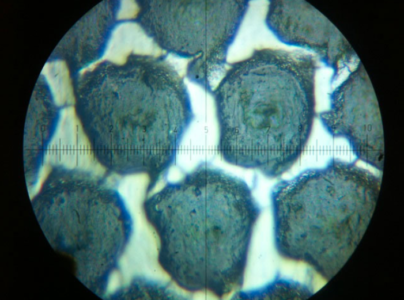Anilox coating systems apply a precisely measured and consistent level of coating to a printed surface. The process uses an anilox roll, which is a hard cylinder with metal core and usually a ceramic surface covered in tiny dimples know as cells. The intention of the anilox pre-coating process is to enable inkjet printing on a broader array of media, enhance the overall appearance and make the printed piece more durable. When all goes well, pre-coating can create the look and feel of offset printing on offset stocks using a production inkjet press.
Sadly, sometimes everything does not go well. On occasion, the formulation of the pre-coating fluid can cause print quality issues that are easily mistaken for print head issues. The underlying culprit is salt. Often, pre-coating formulations that work with aqueous pigment ink contain some amount of salt content. The salt helps catch the pigment flake in the ink and keep it on the surface, but over time it can also cause corrosion of the pre-coating unit.
If that corrosion results in pitting within those tiny cells on the anilox roll, there will be areas of the roll that are not even. The benefits of anilox coating are based on a measured and consistent delivery of coating to the sheet. If the cells on the drum are compromised, the coating will be uneven, therefore the ink jetted onto the applied coating will respond inconsistently to the areas with more or less coating. Visually, this could look similar to a cross process density issue with spots, hickies and color changes. If the problem exists, it can get worse over time. So, what can you do?
- If you haven’t bought a system yet, ask the manufacturer what their recommended process is for keeping the coating fluid from degrading the surface of the anilox roll.
- You should also make sure to talk to some peers who have had the coating device in production for a period of time, and look at samples to see if you see any sign of defects.
- If everything looks good, and the manufacturer is confident that their product does not have this problem, make sure that is reflected in the warranty on the anilox roll. Your warranty on your coating roll is as critical as your warranty on your print heads. Cells and jets are tiny things with a huge impact on print quality.
Coating systems are an important advancement in production printing that can enable amazing print quality, but like everything else in this very important investment you need to understand the details and protect yourself from any potential risks. That protection includes an investigative buying process, a careful care and maintenance process, well-crafted contracts and potentially an investment in a quality monitoring system.
Help us out by registering (free) and provide some basic information that will help us make Inkjet Insight content more relevant. You can also give us feedback directly on a post you like, a post you don’t like or something else on your wish list. We’re listening and learning.

